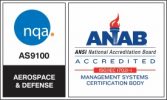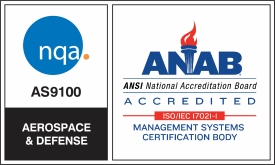Click on a material specification of 4340 Steel to request a quote for our products and services.
| 4340 ALLOY STEEL | UNS G43406 |
| VAR (CEVM) Consumable Electrode Vacuum Melted or Electric Furnace VD | |
| 4340 VAR – 4340V – 4340AQ – E4340 | |
| Description: | |
|
4340 steel is a chrome nickel-molybdenum alloy that is highly versatile and widely used for high-stress parts. It exhibits exceptional properties, including high fatigue strength in large cross sections and excellent transverse ductility and toughness at high strength levels. These characteristics make it a preferred material for demanding applications where strength, durability, and resistance to wear and impact are essential. 4340 steel is available in various forms to meet specific requirements. Here are the popular industry specifications for different forms of 4340 steel: |
|
| Available Forms: | Popular Industry Specifications |
| 4340 Round Bar | AMS 6414, AMS 6415, AMS 6484, AMS 6409, AMS-S-5000, BMS7-28, SS 9702 |
| 4340 Flat Bar | AMS 6414, AMS 6415, AMS 6484, AMS 6409, AMS-S-5000, BMS7-28, SS 9702 |
| 4340 Rectangular Bar | AMS 6414, AMS 6415, AMS 6484, AMS 6409, AMS-S-5000, BMS7-28, SS 9702 |
| 4340 Forged Bar | AMS 6414, AMS 6415, AMS 6484, AMS 6409, AMS-S-5000, BMS7-28, SS 9702 |
| 4340 Forged Block | AMS 6414, AMS 6415, AMS 6484, AMS 6409, AMS-S-5000, BMS7-28, SS 9702 |
| 4340 Machine Ready Blanks | AMS 6414, AMS 6415, AMS 6484, AMS 6409, AMS-S-5000, BMS7-28, SS 9702 |
| 4340 Machined Block | AMS 6414, AMS 6415, AMS 6484, AMS 6409, AMS-S-5000, BMS7-28, SS 9702 |
| 4340 Forgings | AMS 6414, AMS 6415, AMS 6484, AMS 6409, AMS-S-5000, BMS7-28, SS 9702 |
| 4340 Rings | AMS 6414, AMS 6415, AMS 6484, AMS 6409, AMS-S-5000, BMS7-28, SS 9702 |
| 4340 Forged Disks | AMS 6414, AMS 6415, AMS 6484, AMS 6409, AMS-S-5000, BMS7-28, SS 9702 |
| 4340 Hollows | AMS 6414, AMS 6415, AMS 6484, AMS 6409, AMS-S-5000, BMS7-28, SS 9702 |
| 4340 Plate and Sheet | AMS 6454 (VAR PLATE), AMS 6359 |
|
For more information on 4340 steel, call Aero-Vac at 877-237-6822. 4340 Steel Applications:Aircraft Landing Gear:Its high strength and toughness make it suitable for withstanding the stresses and loads experienced during takeoff, landing, and ground operations. Automotive Systems:Where strength, durability, and impact resistance are crucial 4340 steel is employed in components such as crankshafts, axle shafts, gears, and connecting rods. Oil and Gas Drilling:4340 steel finds application in the oil and gas industry, particularly in drilling equipment and tools due to its high strength and resistance to wear and fatigue in harsh environments. Forging:4340 steel is utilized in the production of forged components such as shafts, gears, and other critical parts that require high strength and durability. Warm and Cold Forming:The formability allows it to be shaped through warm and cold forming processes. It is used in applications where complex shapes or intricate designs are required, such as in the manufacturing of machine components and structural parts. Machine Building:Utilized in the construction of machine frames, gears, shafts, and other critical components. Transfer Systems (Power transmission gears and shafts): Well-suited for power transmission systems and the production of gears, shafts, and other components that transmit power and torque. General Engineering Industries: Manufacturing of heavy-duty shafts, pins, couplings, chucks, and molds, among others. Structural Use Applications:Construction of heavy-duty structures, such as bridges, cranes, and industrial equipment, where the material needs to withstand high loads and harsh conditions. 4340 Steel Grade Heat Treatment: Stress Relieving:4340 steel is heated to a temperature between 500 to 550°C. Then to 600°C – 650°C, ensuring uniform temperature throughout the section. Soak for 1 hour per 25 mm section and cool in still air. Annealing:Heat to 844°C (1550°F) and then slowly cool at a rate not exceeding 10°C (50°F) per hour down to 315°C (600°F). From 315°C (600°F), then air cool. Tempering:4340 steel should be heat treated or normalized and heat treated before tempering. The tempering temperature depends on the desired strength level. For strength levels in the range of 260 – 280 ksi, temper at 232°C (450°F). For strength levels in the range of 125 – 200 ksi, temper at 510°C (950°F). It is advised not to temper the 4340 steel if it falls within the 220 – 260 ksi strength range, as tempering can degrade the impact resistance at this strength level. Temper brittleness should be avoided within the range of 250°C – 450°C. Flame or Induction Hardening:Pre-hardened and tempered 4340 steel can undergo further surface hardening through flame or induction hardening methods, achieving a case hardness exceeding Rc 50. The steel should be heated quickly to the austenitic temperature range of 830°C – 860°C and then quenched in oil or water depending on the required hardness, workpiece size/shape, and quenching arrangements. After quenching and reaching a hand-warm temperature, tempering at 150°C – 200°C can reduce stresses in the case without significantly affecting its hardness. It is essential to remove any decarburized surface material before surface hardening. Nitriding:4340 steel can be nitrided to achieve a surface hardness of up to Rc 60. Heat the steel to 500°C – 530°C and hold for a sufficient time (typically from 10 to 60 hours) to develop the desired case depth. Slow cooling without quenching helps minimize distortion. Machining should be done with a small grinding allowance after nitriding, as the core tensile strength of the 4340 steel is usually not affected due to the nitriding temperature being below the original tempering temperature. Achievable surface hardness through nitriding is 600 to 650HV. Machinability:4340 steel is best machined in the annealed or normalized and tempered condition. It can be readily machined using conventional methods such as sawing, turning, and drilling. However, in high-strength conditions of 200 ksi or greater, the machinability is reduced to 25% to 10% of the alloy’s machinability in the annealed condition. Welding:Welding of hardened and tempered 4340 steel is not recommended, as it can result in quench cracking and alter the mechanical properties within the weld heat-affected zone. If welding is necessary, pre-heat the steel to 200°C to 300°C and maintain this temperature during welding. After welding, stress relieve at 550°C to 650°C before hardening and tempering. If welding in the hardened and tempered condition is unavoidable, it is advisable to stress relieve the workpiece at a temperature 15°C below the original tempering temperature. |
|



